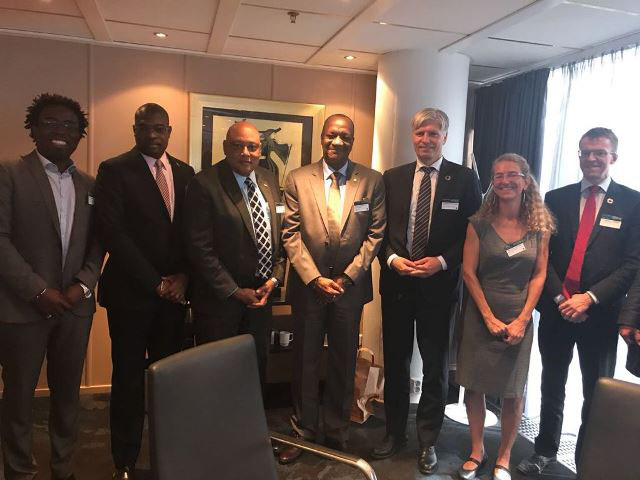A large-scale solar farm to supply about 100MW to the national grid is in the works and will soon be unveiled as government moves closer towards it 2025 green energy target and satisfying the requirements for access to a large tranche from the Kingdom of Norway, sources say.
The Governments of Guyana and Norway met in Oslo late last month and agreed to move their climate, forests and sustainable development co-operation forward with determination.
This newspaper understands that the essential point of the meeting was the agreement to extend the partnership, based on the letter and spirit of the original 2009 MOU between the two sides, and focus investments on solar energy as expeditiously as possible.
Under the 2009 deal, Norway agreed to pay up to US$250 million over five years for Guyana’s performance on limiting greenhouse gas emissions from deforestation and forest degradation, and for progress made against governance-related indicators. Only a small amount of this money has been utilized and monies are still to be assigned based on performance.
Guyana’s delegation, comprising Ministers of State, Natural Resources and Public Infrastructure in Joseph Harmon, Raphael Trotman and David Patterson respectively, expressed to the Norwegians, that this country’s plan was to invest heavily in the development of solar energy and Guyana would use the bulk of the remainder of the monies under the Norway deal towards this cause.
It is towards those plans that Norway will soon reach out to the Inter-American Development Bank (IDB) to have arrangements made to make the monies they hold available to a fund designed to support Guyana’s solar power ambition.
The IDB is currently holding US$80m in funds from the 2009 Norway forest protection deal. The money was to be Guyana’s equity contribution in the 165 mw Amaila Falls Hydropower Project (AFHP) which the current APNU+AFC government has virtually abandoned. Norway has insisted that the money could only be applied to a project verging on the scale of AFHP and clean energy-based. This had been a stumbling block as the APNU+AFC government had mustered only a small number of small-scale solar projects.
Late last year, Director of the Norwegian International Climate and Forest Initiative (NICFI) Per Fredrik Pharo had told Stabroek News that the “ball is in Guyana’s court” to produce a renewable energy transition plan that is a prerequisite for the release of US$80 million.
“Guyana needs to establish a credible pathway to a clean and renewable energy transition in line with its NDC [Nationally Determined Contributions] and our original agreement,” Pharo had said, in response to inquiries about the delay in the release of the US$80m.
“This must be done through a public policy document with formal status. In this document Guyana also needs to reiterate that the general approach of keeping Guyana’s forests protected against intrusion remains government policy,” he added, while noting that a plan is yet to be received.
But sources close to both sides told this newspaper that the Guyana delegation took a plan to Oslo which laid out a vision to invest heavily in solar and which the Norwegians believe can be realized and will work with this country in achieving. Government also explained its planned use of natural gas from offshore oil wells as part of the energy mix. Norway has frowned at
natural gas as part of the energy mix.
While Norwegian officials believe it is too early to tell to which specific projects the monies will be used for, government is currently considering a large scale solar farm, which depending on costs will provide about 100MW of power with several hours of storage. Another alternative being looked at revolves around two 50MW solar farms with battery storage facilities. Either choice will see the power generated being connected to the current grid.
While no costs were given, it was explained that an estimate for the 50MW farm would depend on location and other factors. However, government would have to add to the available funding from Norway to arrive at 100MW.
The Georgetown delegation also explained its plans of introducing natural gas in its energy mix, as part of meeting its 2025 clean and renewable energy target.
Government has argued that natural gas will be readily accessible when oil production offshore begins in 2020. Thus the David Granger-led government policy makers believe that natural gas use should be maximized, even as it works towards weaning itself off of non-renewables.
“Norway was very concerned about the use of natural gas but now we have addressed their concerns,” one source said.
When Pharo was last year asked if Guyana’s natural gas initiatives would be accepted as part of the “Green Plan,” he would only say, “We are waiting for Guyana’s proposals. Guyana’s stated goal is a very quick transition to near 100% clean and renewable energy by as early as 2025” but maintained that Norway is committed to working with Guyana to achieve its target.
‘Focus’
The Norwegians said that their focus at this point is on solar power, although they stated that the GOG maintains natural gas power generation as an option for the future.
During his visit to India, in March of this year, President David Granger told an International Solar Allegiance Conference that sun rich states like Guyana should have access to the necessary solar technologies.
He had also urged the international body to ensure that small states benefit from investment, innovative technologies, photovoltaic infrastructure, information-sharing and the dissemination of scientific and technological data saying that Guyana’s ‘green’ development thrust is not only about environmental and economic security, but that it is also about energy security.










